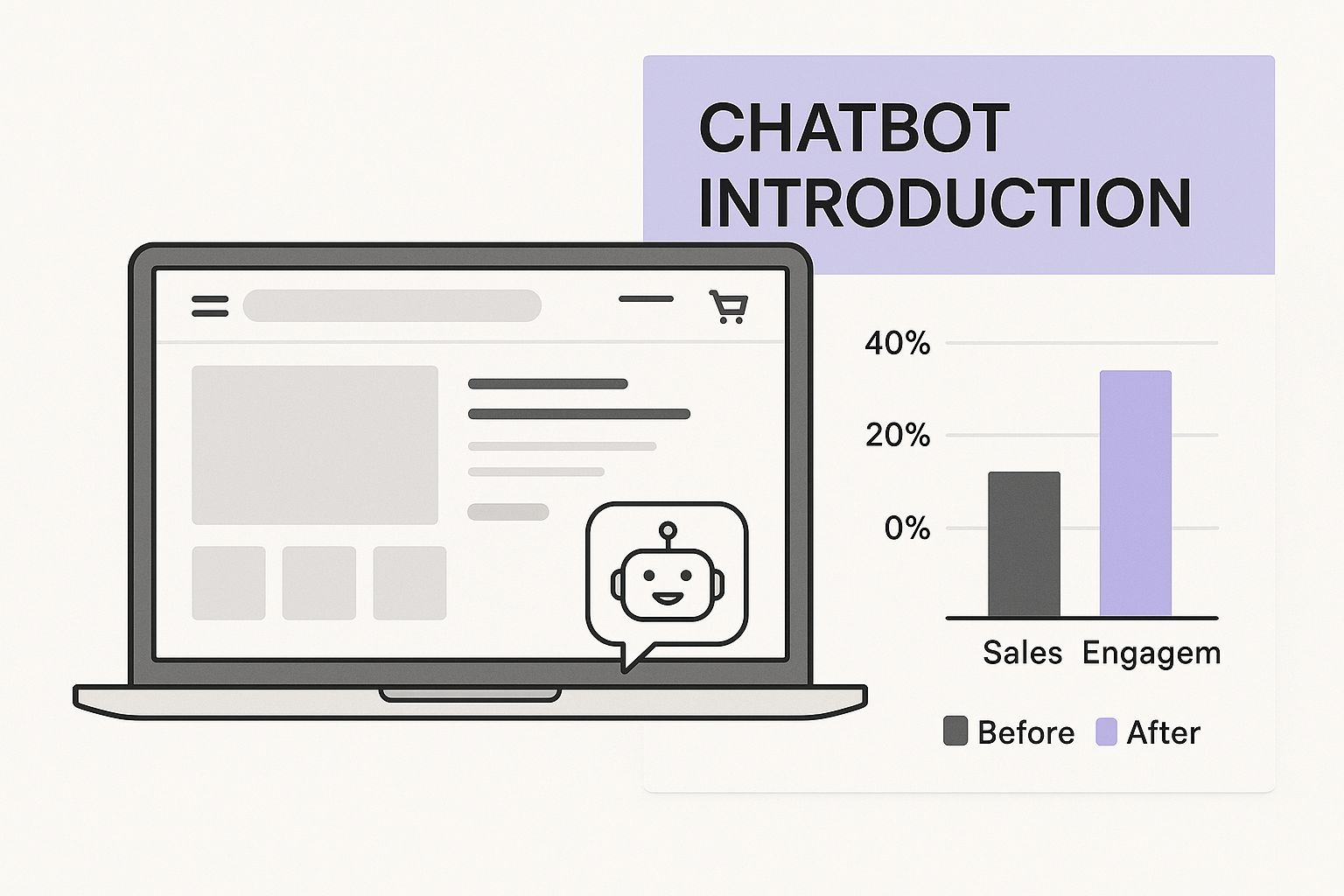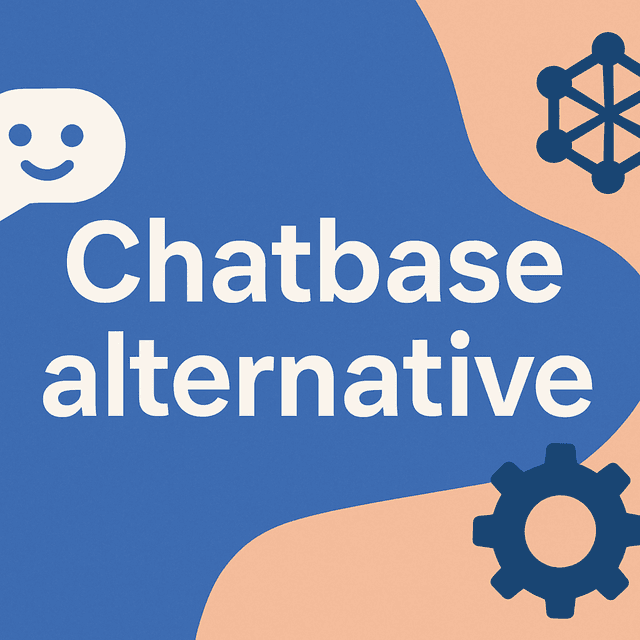The New Retail Reality: Why Chatbots Are Changing Everything

The infographic above showcases a modern ecommerce website with a built-in chatbot for ecommerce. It illustrates how seamlessly these tools are integrating into the online shopping experience. The readily available chatbot visually emphasizes the growing importance of proactive customer engagement and immediate support.
Today’s ecommerce world requires more than just product listings and contact forms. Customers want personalized, instant help, and chatbots are stepping up to deliver. This change represents a fundamental shift in how retail works.
Imagine a customer shopping online late at night with a quick question about sizing. A chatbot can instantly provide that information, potentially saving a sale. This immediate support is why major retailers are now heavily investing in conversational AI. Looking at how chatbots are changing online commerce, it's interesting to consider how integrating voice could make the user experience even better. You can find out more about chatbot with voice platforms.
The Psychology of the Chatbot Shopper
Today's shoppers are busy and value quick, convenient service. They don’t have time to search for information or wait on hold. Businesses need to adapt to these evolving expectations.
Chatbots address this need by giving immediate, personalized help. They act as digital assistants, guiding shoppers through the purchase process, answering questions, and even making product suggestions.
This personalized approach builds trust and strengthens the brand-consumer relationship. Plus, chatbots can provide 24/7 support, essential in our global market.
From Novelty to Necessity: The Evolution of Chatbots
Early chatbots often felt robotic and impersonal. However, advances in Natural Language Processing (NLP) and machine learning have made them far more sophisticated.
Now, chatbots can understand complex requests and offer human-quality interactions. They're not just a novelty anymore; they're crucial for businesses to remain competitive. This shift is driven by the increasing consumer demand for personalized, readily-available help.
The growth of chatbots in ecommerce has significantly impacted transaction volumes. In 2023, chatbot transactions reached $112 billion, showing a considerable increase in consumer engagement and trust. By 2025, this figure is projected to reach $142 billion.
To better visualize this growth, take a look at the table below:
Chatbot Transaction Growth in Ecommerce Visualization of the dramatic growth in chatbot-facilitated transactions in the ecommerce sector over time
| Year | Transaction Volume (in billions) | Growth Percentage | Consumer Adoption Rate |
|---|---|---|---|
| 2023 | $112 | - | 33% |
| 2025 | $142 | 26.8% (projected) | - |
This table highlights the dramatic increase in transaction volume handled by chatbots, reinforcing their rising importance in online retail. The growing preference for chatbots among consumers, with 33% wanting to use them for tasks like placing orders, is also fueling this trend.
As ecommerce keeps changing, chatbots will continue to play a vital role in improving customer service and boosting sales. You can find more detailed statistics here. This rapid growth makes the increasing importance of chatbots in the retail landscape perfectly clear.
Transforming Customer Service From Cost Center to Profit Driver
E-commerce has evolved. It's no longer enough to simply display products online. Today's customers expect personalized, readily available support throughout their entire shopping experience. This shift is transforming customer service from a cost center into a profit driver, and chatbots are leading the charge. These AI-powered tools can handle a wide range of tasks, from answering simple questions to providing complex product recommendations, ultimately creating a seamless and engaging experience for customers.
Beyond Basic Support: Elevating the Customer Experience
Imagine a customer browsing your online store at 2 AM, unsure about a product's specifications. A chatbot can instantly address their concerns, preventing a lost sale. This 24/7 availability is a key advantage. Chatbots can answer FAQs, provide order updates, and even guide customers through the checkout process.
They can also maintain a consistent brand voice, ensuring that every interaction reflects your company's personality. This personalized approach builds brand loyalty and fosters trust. It's particularly valuable for upselling or cross-selling related products.
From Resolution to Revenue: Turning Interactions into Opportunities
While handling routine inquiries is important, the real strength of chatbots lies in their ability to drive sales. By integrating with your CRM and inventory management systems, a chatbot can offer personalized product recommendations and address customer objections in real-time.
For example, if a customer abandons their cart, a chatbot can send a personalized message offering a discount or highlighting the product's benefits. This proactive engagement can significantly reduce cart abandonment rates and increase conversions.
This shift towards proactive engagement also frees up human agents to focus on more complex issues and high-value customer interactions. This strategic allocation of resources optimizes efficiency and improves overall customer satisfaction.
The Power of Data: Measuring Chatbot Success
The success of a chatbot can be measured through key metrics:
- Resolution times
- Customer satisfaction scores
- Conversion rates
Monitoring these metrics helps businesses identify areas for improvement and optimize their chatbot strategies.
Analyzing conversation logs can also reveal valuable insights into customer preferences and pain points. This data can inform product development, marketing strategies, and overall business decisions.
Chatbots have become essential for enhancing customer support and sales. The global chatbot market, which includes e-commerce, is expected to reach $9.56 billion by 2025. The retail and e-commerce sector holds a significant 30.34% market share of this market, largely due to chatbots' ability to offer 24/7 support, reduce response times, and automate routine tasks. Learn more about chatbot statistics. This underscores the importance of integrating chatbots into a successful e-commerce strategy. Forward-thinking brands are using these tools to improve customer service, drive sales, and boost their bottom line.
The Conversion Secret: How Chatbots Drive Actual Sales

Chatbots are no longer just about answering simple questions. They're evolving into powerful sales tools for ecommerce businesses. Leading brands are using them to actively boost revenue by understanding customer needs and offering personalized guidance toward purchases.
Personalized Product Recommendations That Convert
Personalized product recommendations are a key chatbot strategy. Instead of generic suggestions, chatbots analyze data like browsing history and past purchases to recommend products customers actually want.
For example, a chatbot might suggest items that complement what's already in a shopper's cart. This targeted approach feels more helpful than pushy, increasing the chance of add-on sales.
Abandoned Cart Recovery: Winning Back Lost Sales
Chatbots are also effective for abandoned cart recovery. If a shopper leaves without buying, the chatbot can send a follow-up. This message might offer a discount, remind them about the items, or simply ask if they have questions.
These timely interventions can significantly reduce cart abandonment and recover lost revenue. Integrating live chat, similar to strategies discussed in resources like Shopify Live Chat, can provide immediate support.
Upselling and Cross-Selling Without Being Pushy
Chatbots are great at upselling and cross-selling without being aggressive. By understanding customer preferences, they suggest relevant upgrades or complementary products in a natural way, enhancing the customer experience.
For example, a chatbot might suggest a higher-end camera model or recommend accessories like lenses if a customer is browsing a specific camera.
Building Confidence and Addressing Objections
Chatbots build purchasing confidence by addressing common objections proactively. They can offer detailed product information, showcase positive reviews, or highlight guarantees.
Adding social proof, like showing how many others recently bought a product, can also encourage conversions. This reinforces the product's value.
Testing and Measuring for Continuous Improvement
Continuously testing and measuring your chatbot's performance is essential. Analyzing conversations and tracking metrics like conversion rates and average order value provides valuable insights.
This data helps refine the chatbot's responses and optimize its performance. This iterative approach ensures your chatbot adapts to customer needs and maximizes sales potential.
To illustrate the impact of sales-focused chatbots, let's look at a comparison of key metrics.
Chatbot Sales Impact Comparison
Comparative analysis of key performance indicators for ecommerce stores before and after implementing sales-focused chatbots.
| Performance Metric | Without Chatbot | With Chatbot | Percentage Improvement |
|---|---|---|---|
| Conversion Rate | 1.5% | 3.0% | 100% |
| Average Order Value | $50 | $60 | 20% |
| Cart Abandonment Rate | 70% | 50% | 28.6% |
| Customer Satisfaction | 75% | 85% | 13.3% |
This table demonstrates how chatbots can significantly improve key ecommerce metrics. The implementation of a chatbot resulted in a 100% increase in conversion rate, a 20% increase in average order value, and a 28.6% decrease in cart abandonment rate. Customer satisfaction also saw a notable 13.3% increase. These results highlight the tangible benefits of incorporating chatbots into your sales strategy.
Choosing Your Chatbot: Beyond the Sales Pitch
Finding the perfect chatbot for your ecommerce business requires more than just believing the marketing hype. It demands a thoughtful evaluation of your specific needs and a solid understanding of the available chatbot technologies. This guide offers practical advice for navigating the world of chatbots and selecting the ideal solution for your business objectives.
Understanding Chatbot Technologies
Chatbots come in various forms, from basic rule-based chatbots to sophisticated AI-powered platforms. Rule-based chatbots operate on pre-defined scripts. This makes them suitable for handling simple tasks like answering frequently asked questions. However, they struggle with complex or nuanced questions.
On the other hand, AI-powered chatbots utilize Natural Language Processing (NLP) and machine learning. This allows them to understand and respond to a broader spectrum of customer interactions. They can handle more complex conversations, offer personalized recommendations, and even learn from past interactions. Platforms like FlowGent AI offer these robust AI capabilities, leading to more sophisticated and human-like interactions.
Key Features to Consider
When comparing chatbot solutions, consider these vital features:
- Natural Language Understanding (NLU): NLU dictates how effectively a chatbot grasps customer intent, even with variations in phrasing or complex sentences.
- Platform Integrations: Smooth integration with your existing ecommerce platform (Shopify, WooCommerce, etc.), CRM, and other business systems is essential for streamlined operations.
- Multilingual Support: For businesses with a global customer base, multilingual support is key to providing effective assistance. FlowGent AI supports over 95 languages, a significant advantage for international companies.
- Scalability: Your chosen chatbot should handle growing conversation volumes without performance issues as your business expands.
Beyond the Features: Practical Considerations
Choosing a chatbot involves more than just a checklist of features. Consider these practical aspects:
- Implementation Challenges: Realistically assess the time and resources needed for setup and integration. While some platforms promise easy setup, integrating with current systems can sometimes pose unexpected hurdles.
- Budget: Chatbot pricing can vary greatly. Find a balance between cost, functionality, and your anticipated return on investment.
- Internal Resources: Evaluate the in-house expertise required to manage and maintain the chatbot. No-code platforms like FlowGent AI minimize the need for extensive technical skills.
Matching Solutions to Your Goals
Different business goals call for different chatbot strategies. A rule-based chatbot handling FAQs might be sufficient if your main objective is to lower support costs. If you're aiming to personalize the customer experience and boost sales, an AI-powered solution like FlowGent AI might be a better fit.
Think about how different chatbot types align with your specific requirements. A hybrid approach, combining rule-based logic with AI capabilities, could be the optimal choice for complex product customization.
Choosing a chatbot is an investment in your business. By thoroughly considering these factors, you can look beyond the marketing and find the solution that truly delivers results. Focusing on your specific business goals and understanding the nuances of each platform will lead you to the right chatbot for long-term success. Honest assessments of capabilities are vital for achieving a positive ROI.
Integration That Works: Making Chatbots Part of Your Store

Integrating a chatbot into your ecommerce store is more than just installation. It requires a robust omnichannel communication strategy for seamless functionality and a positive customer experience. This guide walks you through key integration steps.
Connecting With Your Ecommerce Platform
The first step is connecting your chatbot with your ecommerce platform. Ensure compatibility and smooth data flow, whether you use Shopify, WooCommerce, Magento, or another platform. This connection lets the chatbot access product information, customer data, and order details, enabling personalized interactions. For instance, if a customer asks about a product, the chatbot can display live inventory and pricing.
FlowGent AI offers seamless integrations with major platforms, simplifying this process. Its no-code platform makes setup easy, even without extensive technical expertise. This integration streamlines operations and boosts efficiency.
Integrating with CRM, Inventory, and Order Management
Linking your chatbot to your CRM, inventory, and order management systems is crucial for a complete view of the customer journey. This empowers the chatbot to provide accurate order status, shipping details, and even personalized recommendations based on past purchases. For example, it can alert customers about shipping delays or suggest related products based on browsing history.
Placement and User Experience
Strategic chatbot placement maximizes engagement. Consider where customers need assistance most, such as product pages, FAQs, and checkout. Avoid intrusive pop-ups that disrupt shopping. Instead, use subtle cues like a clickable chat icon.
Maintaining Brand Consistency
Your chatbot should reflect your brand. Ensure its voice and tone align with your brand identity. This creates a cohesive customer experience and reinforces brand recognition. Platforms like FlowGent AI offer customizable agent profiles to tailor the chatbot's personality.
Designing Natural Conversational Flows
Chatbot success hinges on conversation quality. Design natural-sounding conversational flows. Use clear, concise language, avoid jargon, and anticipate common questions. Multi-step workflow builders within platforms like FlowGent AI can help create complex conversations.
Troubleshooting and Testing
Before launch, thoroughly test functionality across devices and browsers for a consistent user experience. Fix glitches and refine conversations based on feedback. FlowGent AI's real-time logs help with this. Regular monitoring after launch is key for addressing potential issues.
Implementing a chatbot can significantly cut support costs by up to 70%, generate 35% more qualified leads, and improve customer retention by 40%. Following these strategies transforms your chatbot into a powerful asset. It enhances customer service, drives sales, and builds brand loyalty. Don't just install it – integrate strategically. Focus on building conversational AI that adds value to the customer experience, rather than just automating responses. This builds trust, improves conversions, and strengthens your brand.
Measuring What Matters: Chatbot Metrics That Drive Growth
Implementing a chatbot for your ecommerce business is only the first step. The true measure of success lies in understanding its performance and using data to continuously improve it. This means looking beyond superficial metrics like the number of chats and focusing on Key Performance Indicators (KPIs) that directly impact your profits.
Key Performance Indicators (KPIs) for Ecommerce Chatbots
For ecommerce, several KPIs provide valuable insights into chatbot effectiveness:
-
Resolution Rate: This measures the percentage of customer issues resolved by the chatbot without human intervention. A high resolution rate indicates effective automation and a positive customer experience.
-
Conversion Attribution: How many sales are a direct result of chatbot interactions? Tracking this reveals the chatbot's power as a sales tool.
-
Customer Satisfaction (CSAT): Measure customer happiness with post-chat surveys or feedback options. High CSAT scores often lead to improved customer loyalty and positive referrals.
-
Average Order Value (AOV): Do customers interacting with the chatbot spend more? An increase in AOV suggests the chatbot is successfully upselling and cross-selling.
-
Customer Lifetime Value (CLTV) Impact: Analyze how chatbot interactions influence long-term customer value. Do these customers become repeat buyers?
Building an Actionable Dashboard
Leading retailers don't just collect data; they use it strategically. They create dashboards that visualize these KPIs, offering actionable insights.
A well-designed dashboard should highlight key trends, pinpoint areas for improvement, and track progress. This lets you quickly identify problems and make data-driven adjustments to your chatbot strategy.
A/B Testing for Continuous Optimization
A/B testing is crucial for refining chatbot performance. Experiment with different:
-
Conversational Flows: Test variations in dialogue to find what connects with customers.
-
Response Options: Offer different choices and analyze which lead to higher conversions.
-
Engagement Approaches: Experiment with proactive versus reactive engagement strategies.
Even small changes can make a big difference. For example, a simple wording change in a product recommendation can significantly impact conversions.
Analyzing Conversation Logs: Uncovering Hidden Opportunities
Beyond the numbers, dive into the actual conversations. Analyzing conversation logs offers valuable qualitative insights, helping you identify:
-
Friction Points: Where are customers struggling or getting frustrated?
-
Expansion Opportunities: Are there unmet customer needs or potential upselling opportunities you haven't considered?
-
Areas for Improvement: Can the chatbot's responses be more helpful or personalized?
By understanding customer conversations, you can refine your chatbot's performance and discover new ways to increase ROI. This can reveal potential pain points that inform future product development and help personalize the shopping journey, building stronger customer relationships.
For example, if customers frequently ask about a product feature the chatbot doesn't address, adding that information can improve resolution rates and customer satisfaction.
By focusing on these metrics and using a data-driven approach, your chatbot becomes more than just a novelty—it becomes a powerful engine for growth, actively contributing to revenue and customer loyalty. It enables you to understand customer behavior, personalize interactions, and ultimately, drive sales.
Ready to transform your customer service and boost your bottom line? Explore how FlowGent AI can empower your business with intelligent, scalable chatbot solutions.



